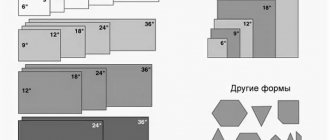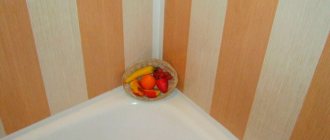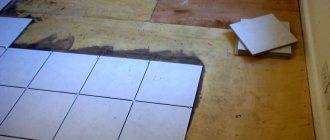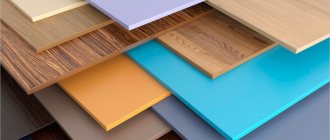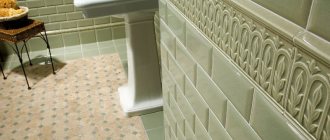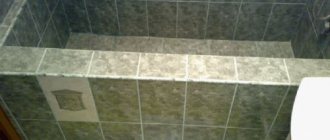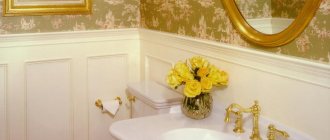The main parameter before starting facing work is choosing the appropriate adhesive. If you decide to renovate your bathroom or kitchen, the mixture must have sufficient moisture and heat resistance to prevent the tiles from slipping and hold them firmly in the desired position. Choose tile adhesive for the bathroom according to several parameters.
What should you consider when choosing?
Key points to pay attention to:
- The weight and some features of the material, as well as its size. For example, almost any option is suitable for fixing ceramics - it is lightweight and securely attached to the base, even with a mixture with a low adhesion rate. For large tiles, stone, marble, granite, you will have to choose an adhesive with increased strength.
- Features of the base, as well as the presence of cracks and irregularities on the surface. Wood and drywall require additional processing so that it sticks even with elastic glue.
- Features of the room, humidity and temperature variability.
Base
Which bathroom tile adhesive to choose depends on the base. The wall can be made of plasterboard, concrete, brick, less often - wood, sand-cement screed, metal, glass, plastic. Manufacturers usually write on the packaging which materials it adheres to best, and which ones it will hold the tiles on very weakly.
Particular attention should be paid to the possibility of deformation of the base and the impact of various types of vibrations on them.
For example, wood begins to swell due to high humidity if it is not subjected to special treatment. In this case, you will have to choose an adhesive that will take into account this feature of the wooden base and will securely hold it in place.
Ceramics
The material is quite light, so choosing glue is not much of a problem. The advantages of ceramics are affordable cost and high levels of moisture resistance and temperature resistance.
Porcelain tiles are considered an improved version of ceramic tiles.
Room
For the bathroom or kitchen, it is recommended to select mixtures that repel water and do not absorb it.
To protect the tile surface after using the adhesive, you can apply a moisture-repellent coating on top, since fumes penetrate through the seams and can cause the adhesive to disintegrate.
Features of choice for different types of tiles
On the packaging, manufacturers indicate the type of tile recommended for this product. It is unreasonable not to pay attention to this information, since proper application guarantees the quality and durability of the finishing coating. Therefore, you need to know what properties glue should have for different conditions and situations.
Mixtures with increased adhesion are necessary in several cases:
- when working with porcelain stoneware;
- when facing complex vertical surfaces;
- on hygroscopic bases.
Experts advise choosing moisture-resistant and high-strength cement-based mixtures for floor tiles, and elastic ones for wall tiles. It is recommended to lay the mosaic with white glue. A similar choice must be made when working with glass tiles. White glue has high adhesion and is in no way inferior to gray cement glue, but, unlike it, it will not spoil the appearance of the translucent mosaic. Instead of cement, you can use dispersion glue.
The choice of composition also depends on the size of the ceramics. The larger and thicker the tile, the greater the weight load the adhesive must withstand. For large-sized tiles, you should choose a composition with enhanced fixation. With it, tiles are laid from top to bottom. Moisture-resistant mixtures are always chosen for tiling bathrooms.
When working with complex surfaces, you need a ceramic tile adhesive that sets slowly and is highly durable once cured. The same composition is used for laying on unstable surfaces made of plasterboard, wood or chipboard, as well as for gluing tiles to old tiles without dismantling them. Universal mixtures are recommended for finishing work in dry rooms.
How to calculate consumption?
It is important to correctly calculate how much glue is needed for repairs. Usually the approximate glue consumption is indicated on the packaging, but you can make the calculations yourself.
How to calculate consumption:
- Determine the area of the surface to be coated. It is calculated by the formula: multiply the width of the room by its length. If the room is of a non-standard shape, you will have to mentally divide it into geometric shapes and add up the areas of each of them.
- Calculate the quantity required for repairs. Divide the area of the kitchen or bathroom by the area of one tile.
- The skill of the specialist must be taken into account. An inexperienced glue master will spend much more glue, since there is a risk of spoiling the composition or using it in excess.
- Much less glue is used on a flat surface - some of it will not accumulate in cracks and irregularities, trying to close them and provide better adhesion to the material.
The consumption will be higher for an inexperienced craftsman who does not know what layer thickness will be enough and may re-lay some slabs. Laying technology also affects the amount of glue.
The approximate consumption of adhesive for tiling is indicated in the table below.
| Size | Adhesive layer thickness | Approximate quantity (kg/m2) |
| 10x10 | 5 mm | 3 |
| 20x20 | 8 mm | 4 |
| 30x30 | 10 mm | 5 |
FAQ
Laying tiles with glue
How to calculate the consumption of tile adhesive?
Most manufacturers indicate the consumption of tile adhesive per 1 square meter of area based on a base layer thickness of 1 mm. It is not recommended to rely on this figure, as it is quite arbitrary.
The fact is that in reality, the manufacturers themselves recommend that when laying tiles, first apply glue to the base with a smooth trowel, and then “comb” it with a notched trowel.
The standard tooth sizes for such spatulas are from 6 to 12 mm. After “combing” you get waves onto which the tiles are laid. Particularly careful manufacturers indicate the consumption in the characteristics of their glue exactly according to the size of the spatula teeth:
| Spatula tooth size, mm | Thickness of the adhesive layer, mm | Mixture consumption, kg/m2 |
| 4 | 2 | 2,1 |
| 6 | 3 | 3,1 |
| 8 | 4 | 4,2 |
| 10 | 5 | 5,2 |
But you can also calculate the flow rate yourself, knowing the height of the teeth and the conditional flow rate for a layer of 1 mm. In practice, when gluing tiles, the height of the waves left by the spatula teeth decreases by 2-3 times, filling the voids and forming a flat surface. Therefore, we take the height of the tooth in millimeters, divide it by 2 and multiply it by the glue consumption for a layer of 1 mm. This will be the actual glue consumption:
Actual flow rate = Teeth height / 2 x Flow rate (1 mm layer)
Example . We lay 10x10 cm ceramic tiles for the kitchen apron. According to the passport, the glue consumption for a 1 mm layer is 1.4 kg per 1 sq.m. Working with a spatula with a 6 mm tooth, we get the real flow rate:
Consumption = 6/2 x 1.4 kg = 4.2 kg per 1 sq.m.
How to dilute tile adhesive?
Diluting tile adhesive
The mixture for tile adhesive is diluted with clean water at room temperature +15..+20°C .
First, water is poured into the glue container, and then the mixture is poured in with constant stirring. To obtain a homogeneous mass without lumps, it is recommended to use a mixer or drill with a special attachment.
The mixed glue is allowed to sit for about 5 minutes so that it “ripens”. Then mix again and get to work.
Can tiles be glued to tiles?
Yes. Some types of tile adhesive allow you to use old tiles as a base. These include, for example, elastic tile adhesive small package Litokol Litoflex K80.
How to remove old adhesive from ceramic tiles (from the back)?
Removing old adhesive from tiles
In order to remove old adhesive from the back of a tile, there are two main methods.
Mechanical method . The glue is removed using a spatula or a metal brush. The process is labor-intensive and long. Some craftsmen automate the process using drill attachments in the form of a steel brush, or using an angle grinder. With this method it is easy to damage the tiles.
Chemical method . The adhesive layer is treated with a special chemical composition (for example, cement remover), which destroys the bonds between the adhesive particles. After which the weakened and softened glue is removed with a spatula or the same brush. Such compounds are poisonous and require careful handling.
Is it possible to lay paving slabs with glue?
Yes. Paving slabs can be laid with tile adhesive. The main thing is to choose the right glue composition so that it is suitable for outdoor use and can withstand more than 50 freezing cycles.
Which adhesive to choose for backsplash tiles?
Kitchen apron covered with tiles
Gluing tiles for a kitchen backsplash is not the most difficult type of tile work. Therefore, there are no special requirements for tile adhesive.
The optimal choice for backsplash tiles would be universal or elastic adhesive. For those who want to save time, quick-curing glue is also suitable. For example, Knauf Schnellkleber. With this glue, after 3 hours you can start grouting the joints.
Types of tile adhesive
There are a large number of adhesive mixtures on the market from different manufacturers. It can be difficult for inexperienced craftsmen to choose an adhesive suitable for a certain type of repair work.
It must be safe for human health, not emit harmful substances and not have a sharp, unpleasant odor. It is better to avoid compositions that take a very long time to dry.
What determines the choice of adhesive for wall and floor cladding:
- Location of the masonry.
- Level of variability of temperature conditions.
- The force of mechanical impact on the tiles (it is greater on the floor, since furniture and other interior items will be placed on it).
- Features of the base (material mobility, presence of heating).
Cement mixtures
When facing walls in rooms with high humidity, cement mixtures are mainly used. Before use, dilute them with water and stir with a construction mixer. In addition to the cement itself, the composition includes additional elements that increase the elasticity and strength of the adhesive solution.
Features of using cement mixtures:
- The glue dries within half an hour. Therefore, dilute it in small portions and move on to the next batch only after finishing the previous one.
- Affordable price and ease of breeding, the ability to buy at any hardware store.
- Universal, suitable for any type of repair work. Consists of hypoallergenic and safe elements.
- Use does not require special skills or craftsmanship.
Dispersion mixtures
Quite expensive compositions, which are still inferior in cost to glue for professional wall and floor cladding.
The main advantage is the flexible elasticity of the composition, which allows it to be laid even on a moving base that is prone to deformation.
First of all, this applies to wood, which swells with high humidity or dries out in the absence of it, as well as plastic, which quickly cracks under the influence of certain factors.
The characteristics of the adhesive allow it to be laid without first using a primer. However, it is better to cover the surface with putty to get rid of cracks.
Elastic mixtures
Latex is added to the mixture, which increases the elastic properties of the glue. It is actively used when laying tiles on heated floors; it is resistant to high temperatures and high humidity. Suitable for wall cladding with natural stone and porcelain stoneware.
Suitable for cladding a “floating” base - for example, wood, which can swell or, conversely, dry out under the influence of moisture or lack thereof. Can be used to repair showers and swimming pools.
Epoxy mixtures
They are rarely used for cladding work. Epoxy glue is very expensive, so it is not as in demand in the market as its main competitors.
Its advantages are increased strength, excellent resistance to moisture, temperatures and mechanical stress.
Typically, epoxy mixtures are used for cladding elevators, recording studios, stairs, and subways. Withstands vibration levels.
Special properties
Tile adhesives are divided into two categories.
- Universal. Suitable for most jobs. They have standard properties and characteristics.
- With improved properties. Designed for use in specific conditions. For example, fillers can be added that increase water resistance, temperature resistance, and provide more elasticity. Antifungal additives may be added to prevent the development of mold, mildew and other harmful microorganisms in materials prone to this.
Fast-hardening
The average time required for universal glue to acquire a given strength is 24 hours. Quick-hardening mixtures dry completely in just 3-6 hours.
Accelerated drying allows repairs to be completed faster. But the time during which the position of the cladding can be corrected if its initial position is incorrect is significantly reduced. For beginners in the bathroom, it is better to take universal compositions.
Leveling
Usually they try to level the surface before any finishing work. It is necessary to buy plaster and putty mixtures. If the unevenness is small (differences up to 5 mm), you can do without putty. Then only glue is used. It will eliminate small defects, fill cracks and depressions.
Elastic
The bathroom is characterized by temperature changes. This is especially pronounced when heating is installed under the floor finishing, and sometimes even the wall finishing. Under the influence of heat, the dried glue expands, begins to collapse, and the tiles fall off. Therefore, the solution must withstand expansion and not crack.
There are two forms - elastic and super elastic. The first is designated on the packaging as S1, the second - S2.
Heat resistant
Not subject to changes when heated. Suitable for use with heated floors. There are brands of adhesives that can withstand up to +600 °C. They are used to decorate stoves with fireplaces.
Frost-resistant
Suitable for outdoor use at very low temperatures. They are also used in rooms without heating, when the floors or walls become very cold in winter.
Thick-layer adhesives
They are used when you need to hold heavy ceramic finishes on the wall. The wall is coated with a solution with an increased layer thickness, reaching 10-12 mm. Since heavy finishes are prone to slipping, thick-layer mixtures are tiscotropic, with increased adhesive characteristics.
Application rules
Tiling walls and floors is not as complicated a process as it seems at first glance. It is not always possible to call a professional technician to your home, since specialist services are not cheap. Therefore, this type of repair work can be performed independently.
You can facilitate the cladding process and increase service life by following the rules:
- Dilute strictly according to the instructions indicated on the package. It is prohibited to change the norms and dosage.
- It is worth starting wall cladding from the floor and gradually moving towards the ceiling.
- Pay special attention to the first row. You can determine its position using a building level. Lay out the remaining rows strictly according to the first.
- It is better to apply it in different directions to improve the adhesion of the material to the base.
- It is applied not only to the tiles, but also to the base itself. Let it dry for a few minutes and only then proceed to styling.
- To ensure equal distance between the tiles, insert small crosses at the future joints.
Basic criteria for choosing adhesive
When choosing tile adhesive, it is important to rely on the following criteria.
Preparing bathroom walls for tiling
- The basis of the surface, i.e. what material the tile will be attached to. This could be plaster, drywall, etc.
- Selected type of tile. A lot depends on him. For example, how much adhesive mixture it absorbs.
- Tile size. The larger it is, the thicker the adhesive layer should be.
- Facing area. On average per 1 sq. m uses about 5–6 kg of glue.
Glue options for bathroom walls
The most important question when renovating is which tile adhesive is best to use in the bathroom. Glue that does not securely fix the tiles can lead to the material slipping during tiling work.
Carefully read everything that the manufacturer indicates on the packaging and pay attention to details.
Such mixtures are approximately similar to each other, however, each of them is used for finishing work of a certain type. For example, an adhesive with a high adhesion rate is better suited for fixing heavy materials; for ordinary ceramics, you can choose a simpler mixture.
Knauf fliesen
The level of adhesion is high, thanks to which it firmly fixes not only ceramic tiles, but also natural stone. Sold in construction stores, the cost is much lower than that of professional compounds.
Don’t forget to also look at Knauf Fliesen tile adhesive: application features
It repels moisture and is resistant to thermal influences, so in the area of the stove and sink, the tiles will not crumble due to the glue drying out.
It is recommended to additionally treat the surface with moisture-resistant grout, since steam (for example, from a boiling kettle) can penetrate through the seams.
Unis 2000
It dries quickly and is highly durable, one of the leaders among the options on the market. Provides reliable fixation and protects it from slipping during repair work. Allows you to lay it from bottom to top, and not just in the standard way.
A high drying speed can cause a lot of problems for inexperienced craftsmen, since there will be no opportunity to change the position of crooked tiles. It is worth diluting the glue in small portions so that it does not lose its basic properties.
More detailed information in the article - Unis glue (Unis): types, characteristics, application
Found mastplix t 12
Does not require additional leveling of the base, fills cracks and uneven areas. The main advantage is the level of elasticity, thanks to which it can be used even on a moving base.
Ceresit cm 11
Suitable for indoor renovations. Used for laying ceramic tiles, porcelain stoneware, small mosaics. An absolutely safe composition, it has no unpleasant odor and is harmless to the human body and pets.
We also recommend watching - Ceresit tile adhesive: varieties and features
Ivsil mosaik
Typically used by professional craftsmen, it costs more than other options presented by the same manufacturer. It has a characteristic white tint, which makes it invisible on tiles of the corresponding shade. Lays down in an even layer, seals cracks and irregularities.
It repels moisture well and is resistant to temperature changes and mechanical stress. Suitable for any type of interior cladding work. Durable and reliable composition, allows it to be laid from bottom to top.
Litoflex k80
Suitable materials are porcelain stoneware, natural stone, ceramic tiles. Safe for human health, does not have an unpleasant odor. Laying on the following types of bases is possible: concrete, metal, brick, wood, cement. Adhesion level is high.
It repels moisture well and is resistant to high temperatures.
Bergauf mosaik
Used for laying small mosaics and glass tiles. Firmly fixes natural stone, porcelain stoneware, marble.
A distinctive feature is the white tint of the composition, which allows you to disguise glue residues on a light-colored surface.
High levels of adhesion and moisture resistance.
Cladding work is possible without preliminary leveling of the surface. Easy to use, suitable for inexperienced craftsmen.
Mira 3130 superfix
The best option for the kitchen or bathroom, the degree of resistance to moisture is one of the highest among the mixtures of this manufacturer. Suitable for laying “capricious” materials such as mosaics and natural stone, decorative elements.
Protects it from swelling, fills cracks and irregularities. Does not require preliminary leveling of the surface. Can be used for external cladding and facade finishing.
Sopro 450
It is sold in the form of a dry mixture; before use, it must be diluted with water or a special solution (to increase the strength of the composition). To ensure the mixture is homogeneous, it is recommended to stir using a construction mixer.
Main characteristics – adhesion, moisture resistance, temperature resistance – high.
Reliably fixes ceramic tiles, stone, mosaic.
Keraflex maxi
Does not require surface leveling, fills cracks and has a high level of elasticity. Suitable for covering walls with large tiles, as well as marble, natural and artificial stone. Laying from bottom to top is possible.
Moment silicone sealant
It is suitable for interior and exterior building cladding.
The main advantage is the presence of antiseptic substances in the composition, which prevent contamination of the base (especially for wooden surfaces) by fungus and other bacteria.
Before use, level the surface with putty so that the glue lays evenly.
Glue: types and purpose
Having assessed the above parameters, you can begin to select an adhesive for tiling your bathroom. The entire adhesive composition is divided into 5 different types.
- Thin layer adhesive . Used when working with smooth surfaces with a difference of no more than 10 mm. Distinctive features of the glue are moisture and frost resistance.
- Thick layer adhesive. Suitable for walls with rough surfaces. Unlike thin-layer adhesive, differences in surface differences can be more than 1 cm. In a sense, this adhesive acts as a primer, leveling surfaces and masking imperfections in the walls.
The thickness of the adhesive layer directly depends on the characteristics of the tile - Elastic glue . Used for finishing concrete surfaces with tiles. It applies perfectly to the surface and also withstands heavy loads.
- Epoxy adhesive. This material is 100% moisture resistant. It is often used as a grout for joints. Glue is a good choice for rooms with large temperature changes.
- Fungicidal glue . It is based on special components that prevent any development of fungus or mold in the bathroom.
Advice. Bathroom tile adhesive must be proven and of good quality. To avoid such troubles as fungus and dampness, you should choose mixtures with an antiseptic.
Adhesive options for bathroom floors
An adhesive intended for lining a bathroom floor must not only repel moisture well, but also be resistant to high temperatures. Fumes can cause the glue to disintegrate, and bathroom floors are often provided with additional heating. Under its influence, the glue should not lose its basic properties or swell.
Otherwise, repeated repairs will have to begin very soon.
Eunice plus
Most often used by both professional craftsmen and beginners. Easy to apply, making application seem very simple.
It is characterized by heat resistance, resistance to frost and moisture. Available on the market in several formats, it can be used for lining showers and swimming pools.
flex
A composition with a high degree of elasticity, suitable for tiling non-standard substrates, as well as those containing rubber-based compounds.
Does not require preliminary leveling of the surface, fills cracks and irregularities.
Sold in any hardware store, the product is not in short supply.
10 strength
This mixture is intended for cladding concrete, metal and brick bases. The high level of adhesion allows you to reliably hold even heavy materials and large tiles.
For better adhesion of the glue to the base, leveling the surface with putty and treatment with a primer is required.
It is not sold as a dry mixture, but in a ready-made version. Before use, you need to pour a small amount of glue into a bucket or bowl and mix well with a construction mixer so that the composition becomes homogeneous.
Siltek t 80
Adhesive for standard facing works. Resistant to moisture, frost, high temperatures. Can be used both indoors and outdoors.
To increase strength indicators, it is recommended to dilute the composition not with ordinary water, but with a special composition (can be purchased at a hardware store).
Choosing a quality adhesive is the first step before starting a repair. The appearance of the tile covering and its integrity and service life depend on the glue. All manufacturers indicate on the packaging the main characteristics of the composition.
Before choosing it, you must clearly know what type of cladding work the adhesive will be used for, and also evaluate the characteristics of the room and the material.
Dry mixture Ceresit cm 11 and 17
When choosing which composition is best for gluing tiles in the bathroom, you should pay attention to the product from the manufacturer Ceresit. The brand of this composition that people pay attention to most often is CM 11. This is a universal mixture used for cladding the house inside and out, which is ideal for laying porcelain stoneware and ceramic tiles in the bathroom. The product is moisture and frost resistant.
For maximum possible adhesion, ceramic tiles must have a water absorption rate of more than 3%. The appropriate size of this material is usually 40x40 cm. The composition is suitable for laying tiles in rooms with a low level of load on the base. It is not recommended to soak the tiles before laying with this adhesive.
When choosing an adhesive for laying tiles in the bathroom, you should read the instructions for installing porcelain stoneware or tiles in advance. The tile is laid on the adhesive and pressed no later than 25 minutes after its application. During this period of time, the position of the tiles will be adjustable, and the glue should stick to your hands. The adhesive contact area of the adhesive composition must be at least 65% on the walls and no more than 80% on the floor surface.
Ceresit cm 17 is a dry mixture with elasticity and adhesion. This allows you to use it not only during the installation of tile covering in the bathroom, but also to lay a deformable base. The production of dry mixture cm 17 is carried out in its usual form and with low dust formation. The product is delivered using special packaging. These are multilayer paper bags of 5 and 25 kg. The average price for them is 560 rubles.
Porcelain tiles to be laid should not be glued end-to-end. The width of the joints can be set depending on the size of the tile material and the conditions of its use. When filling cladding joints, you can use Ceresit grout of group CE no earlier than 24 hours after laying the tiles. The temperature of the air and the base should be +5-30°C. Relative air humidity can be no more than 80%. The dry Ceresit mixture can be stored in packaging without any damage for no more than 12 months from the date of creation in a dry room.
Benefits of dry adhesive
All adhesive mixtures can be divided into dry and ready-made compositions. The obvious advantage of the latter is that they can be used immediately. Dry mixtures require preliminary preparation. Nevertheless, dry mixes are significantly ahead in quality and consumer reviews.
Most craftsmen prefer to work with dry adhesive mixtures
- Possibility of laying tiles on a distorted surface.
- Price. Dry mixtures are much cheaper than ready-made analogues. Moreover, the difference is significant.
- Easy to dismantle old tiles and adhesive base. To remove it you will need a hammer and chisel. For example, polyurethane glue cannot be removed with such tools. It lies on the surface forever, and its service life is more than 45 years. It may seem to some that such performance qualities of polyurethane glue have only advantages. In fact, it is unlikely that anyone will want to see the same tile for such a long time.
Universal glue: pros and cons
This type of glue is used everywhere, which is why it got its name. Suitable for attaching small tiles to a surface. The composition is used in those types of finishing where there are no professional requirements for the design of the room. Universal glue has a number of positive characteristics.
- environmental friendliness;
- wide range of uses;
- suitable for most facing materials;
Universal tile adhesive (ready mix)
- can be used for laying porcelain stoneware;
- has good plasticity indicators;
- used for all types of finishing.
Meanwhile, many experts do not like this adhesive mixture. The reason for this is poor resistance to constant exposure to moisture. For the bathroom, this disadvantage of glue is significant.
